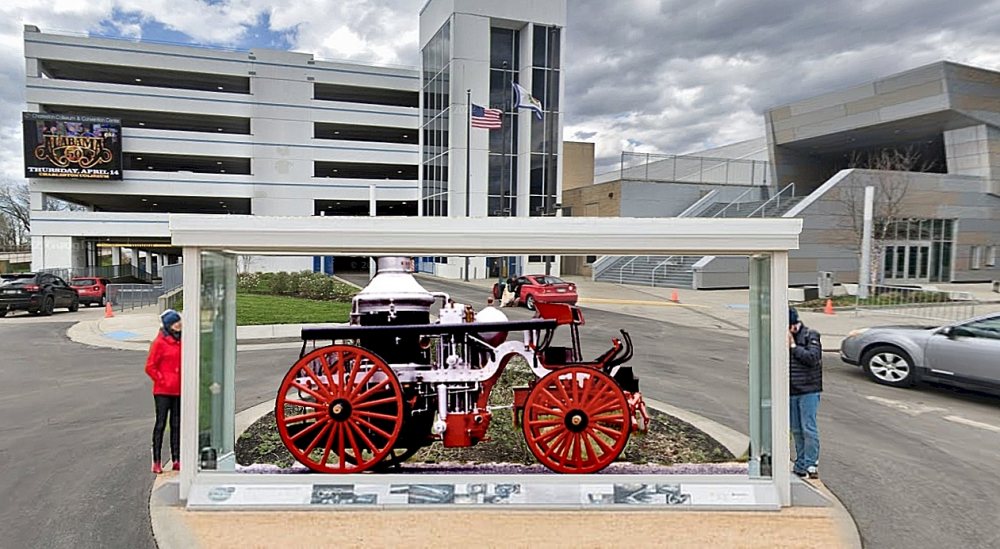The finest fire engine of it's day
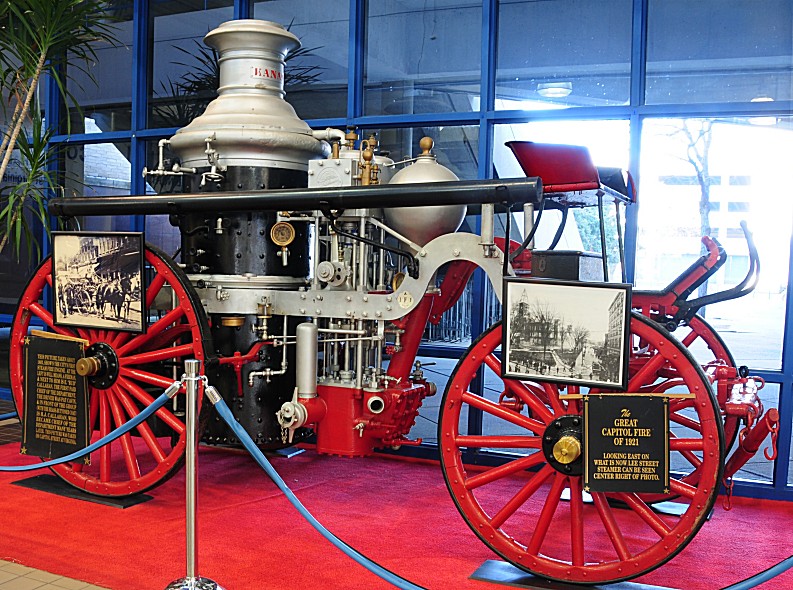
We'll get to a little history on
the old Kanawha Steamer, but first I'd like to tell you how
it wound up in the Civic Center. We have to go back to 1988.
This was the year the Steamer was pulled into Charleston... again.
THE KANAWHA'S BACK
... OR HOW I KIDNAPPED A FIRE ENGINE
Some background.... When the "Kanawha" was put
out of service many years ago by the city of Charleston, the
firefighters union asked that they take ownership. This was
the last steamer, as the other one had been sold for scrap.
So it was decided to allow the firefighters ownership. They
then built a huge trailer to haul the engine, mostly in parades.
They housed the engine for many years in firehouses, but mostly
station 9 on Sissonville Dr. They did what they could to make
the engine presentable, cleaning, sanding and painting.
A real restoration would have cost much more money than they had.
So many many years passed, and the engine appeared in fewer and
fewer parades. The old engine was now just taking up space.
What to do? It was decided to offer the engine to the
WV State Archive. The engine would be placed on display in the relatively
new "Science and Cultural Center" at the state capitol.
It was delivered there and placed in storage until a spot could
be found. Problem was... that spot was never found. So it
sat and sat. Finally ( unbeknown to the firefighters ) the
pumper was hauled to Camp Washington Carver (The site was
dedicated in 1942 as the first 4-H camp for African-American youth
in the nation) at Clifftop to be displayed. Displayed?
For whom? It sat in the weather in the summer and was housed
in the winter. It DID have a roof over it in the summer but
that's no way to treat an irreplaceable heirloom. Once the
firefighters found out about this, they became angry and demanded
that the engine either be returned to the museum, or to them.
This demand fell on deaf ears. Years went by and nothing could
be done. Calls were made to the governor, senators and anyone
who might be able to help. They simply wouldn't move the engine.
Enter yours truly: I had told
them from the beginning that if they wanted the engine back,
just give me the word and I'd have it back in 24 hours. For
years, no one took me up on my offer. Finally, out of sheer
desperation, I was asked to bring the engine back.
I wont go into names, but "certain people" allowed
me the use of a city truck and lowboy. My plan was simple:
Drive to Camp Washington Carver and load the engine and bring it
back. I took enough people with me that if push came to shove...
we'd do that too. The morning that we were on the road to
kidnap the engine, a funny thing happened: "Someone"
became a little worried and made some phone calls. Somehow
those phone calls paved the way for a FAST negotiation process.
As we were loading the engine..... |
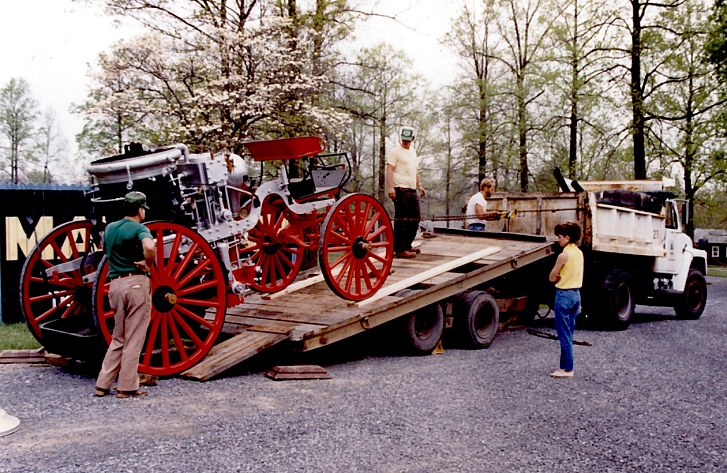
| ..... back in Charleston plans were
made to house the engine in the Civic Center for safe keeping.
Meanwhile, a deal was quickly struck with the state and a contract
written up that the city could have the engine on display for one
year. (yea right). Fact is, I believe that by the time the
state found out that I kidnapped the engine, what could they
do? After all, they knew the city was behind it all and didn't
want to get into a big public fight with Charleston. So we
pulled the engine into the Civic Center, and rolled it into
the lobby. Mayor Kent Hall made a short speech and said the
following: "As long as I am mayor, that engine
will never leave the lobby". Naturally, the news
article glossed over the real story, but it didn't
matter because we got our engine back. So there it sits to this
very day. I made the photos and placards that are there today.
I think the engine looks great because it sits in a cubbyhole that
looks like it was made for it. I hope the day comes that it's
restored to it's once beautiful shape. Helping me "liberate"
the Steamer in the above photo is Jackie Adkins (in green hat) and
Bobby Runion (White t shirt) |
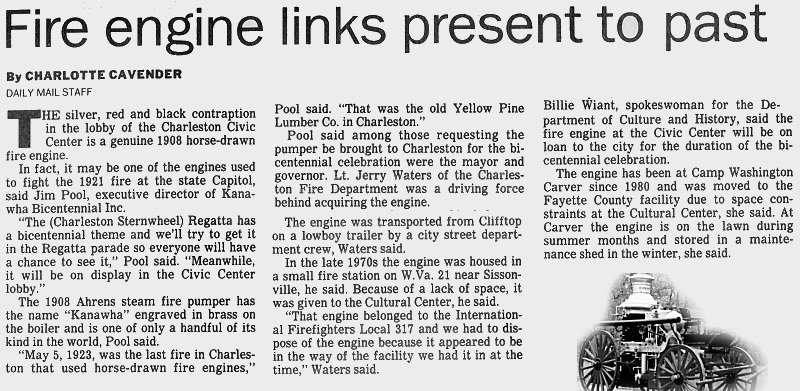
News article June 20, 1988
AND NOW FOR A LITTLE HISTORY
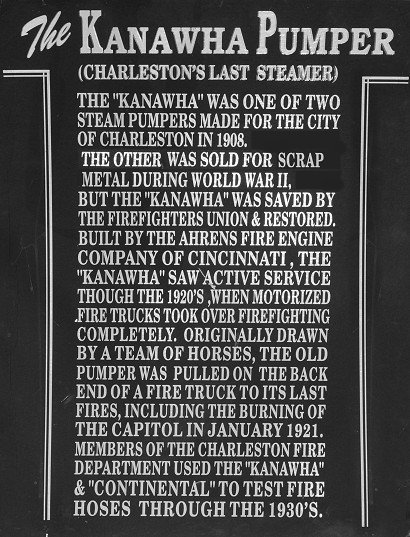
| The first fire company in Kanawha
county was organized in Charleston in the early part of 1864, but,
by some misunderstanding among the members, was caused to suspend.
On February 24, 1864, it was re-organized, with A. E. Summers as
President and William Fisher Secretary. Thomas A. Oliver
was appointed by the company as engine-keeper at a salary of $5
per month. The uniform of the company was a red jacket with black
velvet collar, black pants, black leather belt, with name of the
company on it. The rank of the company included some of Charleston's
most prominent men and numbered seventy-three members. The names
of the engines or apparatuses were Hope and Kanawha. |
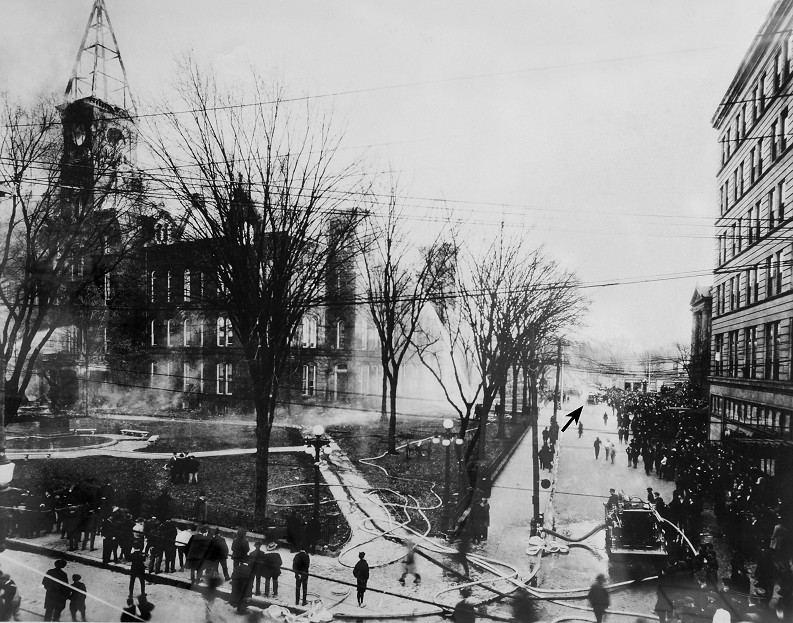
The arrow points to the "Kanawha"
during the great Capitol fire of 1921. Below is a better photo. 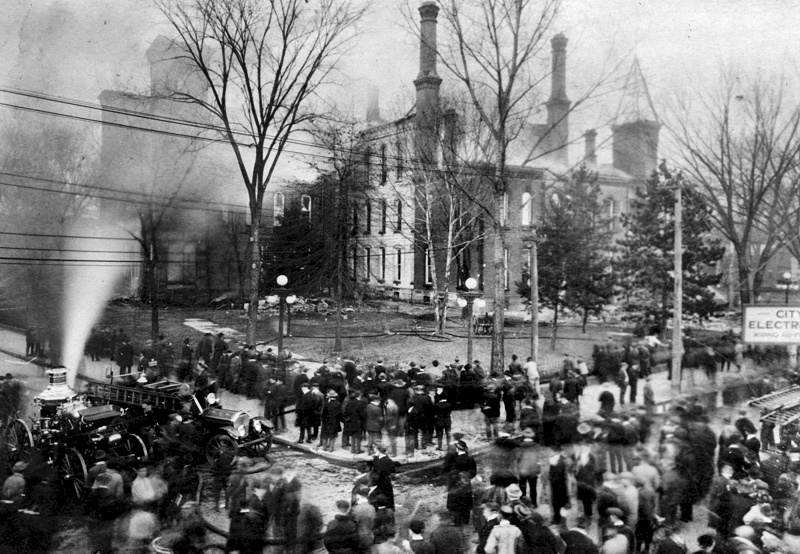
This is the corner of Dickinson & Lee. The Kanawha is going full steam on the left.
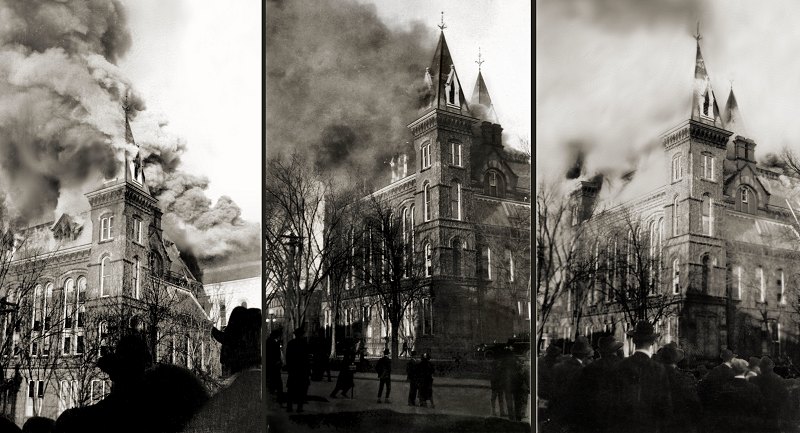
Fire horses came in three classifications:
* The lightweight: 1,100 pound horses that were
used on the hose wagons,
* The middleweight: 1,400 pound horses that were used on the steamers,
and
* The large, 1,700 pounders that were used to pull the hook and
ladders as well as other heavy equipment. Fire horses required much stamina and
strength and natural ability. One expert of the time said it was
usually a one-in-a-hundred selection. Their training took between
one and two years. Many horses were "very spirited"
and non-conformist in nature, but with a patient and knowledgeable
trainer, would turn into a top-notch reliable fire-horse. Just think
of 3 large horses fastened to a very heavy steamer, galloping full
speed through busy streets (and hills) of Charleston, between throngs
of other wagons, buggies, horses, trolley cars, etc. The horses
and the driver had to make quick judgments constantly. Even Charleston
had railroad-type interurban cars in its days of fire horses. The
horses would have to have above-average intelligence to serve, but
after forty years of working closely with
the horses, firefighters no longer bunked in the stable-firehouse
to be ready to hitch the horses to the engines at any hour. The
sound of hooves clattering through the streets, straining to get
pumping equipment to the fire was replaced by the roar of engines. |
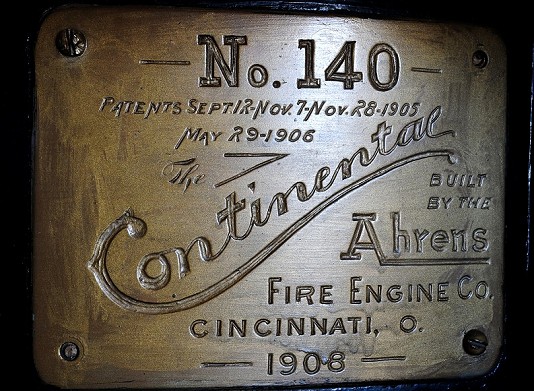
In March of 1852, a Cincinnati locksmith
named Abel Shawk, a railroad locomotive builder named Alexander
Bonner "Moses" Latta, and a iron-foundry owner named Miles
Greenwood, joined forces to build the world's first successful steam-powered
fire engine. There was a young apprentice
working for Shawk and Latta in their factory by the name of Chris
Ahrens. When Shawk and Latta sold their business in 1863 to Lane
& Bodley, a local machine shop, Chris Ahrens became superintendent
of fire engine construction. Five years later Ahrens bought out
the Latta fire engine business, renaming it C. Ahrens & Co.
In 1877, Ahrens renamed his company
the Ahrens Manufacturing Company. By 1903, Ahrens fire engines held
every world record for steam fire engine performance. When one was
broken a new Ahrens engine would set a new record.
In 1891 Ahrens merged with three of its biggest competitors to form
American Fire Engine Company. Chris Ahrens' son-in-law, Charles
Hust Fox, left his position as assistant Chief of the Cincinnati
Fire Department to join the Ahrens firm. One of Mr. fox's innovations
was the Fox Vertical Water Tube Boiler, which could raise steam
from cold water in 3 minutes, and the "Columbian' steamer,
the world's first pumper to carry its own hose. Before this a steamer
required a separate hose wagon to carry its hoses. In 1902 Fox helped
develop the world's first gasoline-powered fire engine.
In 1905 after a protracted legal battle, the Ahrens family separated
the company from the conglomerate that had grown over the years.
It became the Ahrens Fire Engine Company.
The company's new type of fire
engine was the "Continental", it was third in sales and
again garnered every world record, delivering the highest gallons
per minute, the greatest pressure, pumping through the longest length
of hose lines, and shooting streams further and higher than any
other make of steamer of the day.
Charleston
is fortunate to have the finest fire engine of it's day, the Ahrens
Continental
number 140. There is one thing that disturbs me however:
The engine is very heavy and is standing on it's original wooden spoke
wheels. That's far too much weight for something that old.
There needs to be small stands placed under the engine just enough to
take the weight off the wheels. UPDATE: They did finally
place "jacks" under the axles to take the weight off the wooden wheels.
|
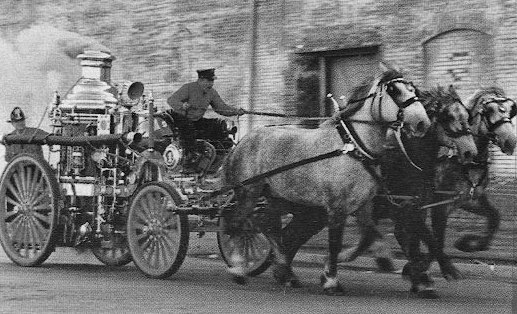
|
2022 UPDATE
In 2015 the Civic Center was being
enlarged. The old Steamer had to be moved. As of this writing,
the Steamer is still in the basement of a fire station, seen by no
one. The Civic Center was greatly enlarged, but they "claim" that
there's no space for the Steamer. Over the last 25 years, Charleston has lost its way. They're trying to make it something it's not.... some kind of artsy fartsy fantasy.
The river and the railroads built this town. Without them, we wouldn't
be here, but do you see any kind of museum or ANYthing that reflects
this? No. And the fire dept had a huge role in protecting this town and
its people. See anything about that? No. "Something" should be out there
for the public to see.
If they dont want the old Steamer in their precious Civil Center, then
they should purchase an enclosure and place it outside on one of the
many spaces around the building. These new enclosures prevent moisture
and the new glass prevent fading.
Here is an example of what it might look like:
|
Back
|









